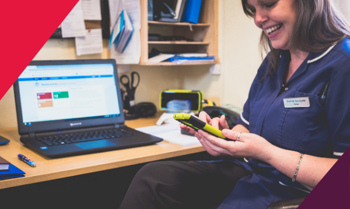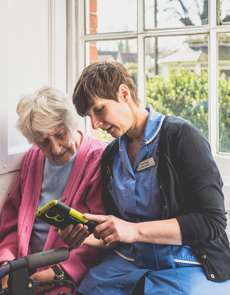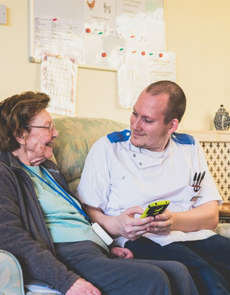Top 13 Considerations When Choosing Your Care Home Management Software
Are you looking into implementing software to improve the efficiency and quality of your care service? Are you worried about making the wrong choice? Doing your research can help you make the best decision for your care service and team.
Once you know what you’re looking for, you can ask the right questions and filter out systems that don’t meet your needs during your search process.
- Will the system give you the insights you need to track, monitor and react promptly to improve outcomes?
- Will it help you respond to, manage and reduce risk?
- Does it meet regulatory requirements and can it help strengthen your compliance?
- Is it easy to use ?
- Can it Integrate between care home systems?
- Does it have pharmacy integration?
- Can it be configured?
- Does it offer offline working?
- Are you buying from a stable supplier?
- Does it offer scalability?
- What is the medicines management functionality like?
- What other systems are available from the supplier?
- Can you see the price and pricing models?
The Importance of Using Care Home Software
Almost every aspect of running a care home can be made easier and simpler when you adopt reliable care home software. These systems can automate or improve a variety of processes, from managing medicines, to care planning or training and employee management.
Managers can use reports to help analyse data, flag up issues and make the best decisions to improve care quality or business performance. These are just a few benefits that care home software brings to your care service.
Following the government's push for all social care providers to have electronic records by December 2023, care providers are expected to maintain and further develop their digital infrastructure in 2025. This means that adopting and optimising digital systems is no longer just an option, it’s an essential part of ensuring compliance, efficiency and high-quality care. However, with so many different systems and options available you might find it hard to choose the best one for you.
At The Access Group, we can help you make the right choice when it comes to selecting a care software. We have helped thousands of care providers digitise their services, and with over 30 years of experience, we know what we’re talking about.
So, to help you make the switch to a digital system with total confidence, here are the top 13 things you need to consider when choosing your care home management software.

1. Will the system give you the insights you need to track, monitor and react promptly to improve outcomes?
With many care services and local authorities adopting an outcomes-focused approach, the system you use must enable you to easily set individual outcomes, track progress towards them and better understand the kind of interventions you can make to improve progress towards outcome goals.
To do this properly, the system you choose should have flexible electronic care planning assessments and so on, so you can set and record outcomes. Staff need to be able to easily record progress towards these outcomes in the system, on an ongoing basis.
The system will also need comprehensive reporting so that managers can identify those who are or are not making progress towards their desired outcomes. They should then be able to use the system to ‘drill down’ into individuals to understand why outcomes are not being met.
So, when comparing systems, ensure they give you the ability to record, update and monitor outcomes on an ongoing basis. Assessing care home software from this angle will open up other important aspects of oversight you may want to examine.
For example, does the system have reports on overdue care plan reviews or other key parts of running your service that you want to keep on top of?
2. Will it help you respond to, manage and reduce risk?
Improving safety and reducing risk is a very common motivating factor behind implementing care home software and it is probably one you share.
Certain software will automatically reduce risk, such as moving from MAR to eMAR. But there is also specific functionality you will want to ensure your new system has if you are serious about making safety a priority, reducing risk and responding as best and as fast as possible to any risk-based incidents that occur.
Alerts
Firstly, enquire as to what kind of alerts the system has. For example, if you are implementing a medication management system, will the right people be automatically alerted to missed or late medicines? If a person reports a fall, or a near miss, or uses the system to report any other form of incident such as aggressive behaviour, who gets an alert and how.
Workflow
Next, what happens after an incident? Does the system have any features to help you manage the process? For example, does it automatically create a task for someone to start an investigation? Then is the remaining workflow easy to manage and progress within the system to recommending and implementing actions or changes and then a follow-up to review whether these interventions have had the desired result?
Reporting
Lastly, what kind of reporting or dashboards are included in the system to help you understand where risks are occurring and how? Dashboards can help you track key indicators such as the number of incidents in a specific home and flag any key areas of concern.
More in-depth reports can help identify individuals with low fluid intake for example. Or to uncover patterns such as the relationship between specific medications and falls or high rates of aggressive behaviour at certain times, specific locations or involving certain staff.
What the above describes is a complete system to help you respond to incidents in a way that helps you learn from and prevent them from recurring. Alongside a system that helps you use data to monitor and reduce risk. It should be something you are aiming to have in the care home software you choose.
3. Does it meet regulatory requirements and can it help strengthen your compliance?
Care compliance is the process of following a set of rules, regulations and laws that relate to care services. It can cover a wide variety of practices and observe both internal and external rules. Implementing the right software can help strengthen your compliance while helping your care business meet regulatory requirements.
When it comes to your social care regulator, such as the CQC or Care Inspectorate Scotland or Wales, they will be primarily interested in:
- How the system helps you improve the quality of care, person-centred care and deliver better outcomes for people
- How the system directly increases safety
- How people’s data is kept secure and confidential, but equally available to those that should be able to access it
- That your policies and procedures have been updated as needed to fit with your new system
Depending on the exact type of software you are selecting there are many ways it could help you achieve the above. For example, moving from paper to eMAR will reduce medicine errors and increase safety. A highly developed electronic care planning system with a mobile app can enable you and your care workers to deliver more person-centred care.
So when assessing a system keep these points in mind and once you select a system ensure your policies and procedures are updated.
However, there are also systems available that are directly targeted at improving regulatory compliance, your auditing processes and your rating from your regulator, commonly referred to as Care Compliance Software. If this is an area you are interested in we would recommend adding it to your list of potential solutions or getting in touch with us directly to discuss how it works.

4. Is it easy to use?
How easy the system is to use can drastically reduce the number of resources e.g. time, money, training, etc. required when it comes to offering support to your care providers and back office staff during digitisation. If your care team finds it easy to use a certain system or application, then there will be less need for repeat training sessions and they will be able to adopt their new routine faster, saving your care business time and money in return.
Easy-to-use software will also reduce stress and anxiety when it comes to digitising your care service. Many staff struggle to handle the transition from traditional paper-based methods to modern digital software due to not being ‘tech savvy’ or simply being set in their ways. If a system is easy to get to grips with, your employees will be much more accepting of the change and will be able to adapt faster.
Find out how our care home management software offers an easy-to-use platform to deliver reliable, joined-up care.
5. Can it Integrate between care home systems?
Integrated care systems are not essential, but they’re highly recommended. Integration works by allowing the effortless transition of data and information from one system to another system, improving the functionality of both and reducing admin time.
It speeds up the process of inputting data and information and prevents the need for care home staff to reinput the same data into other systems.
Having integration between certain systems also prevents risks. For example, if the medication system is integrated with the care planning system, your care staff will always have access to up-to-date information regarding what medicines a patient is taking, their dosage, what they have and haven’t taken that day, etc. In return, this improves resident safety while streamlining care planning processes.
To learn more about the top reasons why your care home software should be integrated, we have an in-depth article on the benefits of integrated care home software. You should keep these in mind when researching providers.
6. Does it have pharmacy integration?
To reduce low or missing stock, it’s recommended that care services stay in touch with their primary pharmacy by providing regular inventory updates. Pharmacy integration is a software feature that allows you to integrate your stock levels with your pharmacy, so they can send out the medication you need (without an update) when your supply levels start to get too low.
This is fantastic news for care providers and care recipients, as they can rest assured that they will always have the medication they need in stock. It also saves time on admin and eliminates lengthy stock takes.
When put into operation correctly, EMM (electronic medication management) systems can lower interpretive and dosing errors. They send out clinical alerts and responses to drug shortages, that can quickly inform all sites. This boosts patient safety, liability and communication while keeping an electronic record of medication administered alongside prescriptions.
7. Can it be configured?
A customisable care system is an exceptionally important feature that you must look for in your care home management software. Every care service operates differently and will require its own personalised forms and records tailored to its care recipients and care team. These will often have been fine-tuned over time and staff will be more comfortable with them.
If for example, you implement an electronic care planning system that is rigid and does not allow you to tailor care plan templates and forms to fit your ways of working, then the transition to your new system will be all that harder for you and your staff. You will also lose all of that fine-tuning you’ve accumulated over the years.
Having the ability to easily modify or adjust the electronic care plans, assessment forms and so on, will allow your business to operate smoothly and gather all of the information you require while highlighting mandatory fields and questions that need to be answered.
Another frequently recurring issue we’ve seen is with care services registered outside of England (in Wales, Scotland or Northern Ireland).
They often find the system they have bought has been designed with England in mind, making it to some extent incompatible with the standards of their national regulators (such as the Care Inspectorate Scotland). If the system is easily configurable and therefore flexible, it should not be a problem as many of our customers in Scotland have found.
The same goes for changing regulatory requirements anywhere in the UK, or if you start providing different types of care services (for example complex care, end-of-life care, or community care) that require you to record different information, or in a different way.
Having flexibility in your system means you are flexible and much more adaptable to any changing requirements, be they external or within your care services.
Lastly, configurability doesn’t mean paying the software supplier hundreds or thousands of pounds to make changes for you. When looking at different systems ensure you clarify for that system:
- What changes can be made
- Who can make those changes
- How those changes are made and how easy or difficult it is to do so
8. Does it offer offline working?
Most care home software requires an internet connection to ‘synchronise’ (meaning match up everyone’s updates) updates people are making as they work, for example updating care notes, administering medicines and so on.
The reality is that many care homes or areas of a care home don’t have the best WiFi signal or mobile connectivity. In this case, it’s really important that staff working on a mobile or tablet app can continue to add and update information without a connection.
Then, when their device reconnects to the network, the information they have been adding when they were ‘offline’ is quickly processed and the shared record used by all is updated.
9. Are you buying from a stable supplier?
From saving money to ensuring good data security, going with a stable supplier should be a high priority when choosing your care home management software. There are a few things you can do to distinguish a stable supplier from an unstable supplier, such as:
- Reviewing their products and feedback – If they have a good range of products and strong, positive customer feedback from multiple users, then the company is more likely to be stable. The more products and feedback, the better.
- Checking the number of years they’ve been operating – Most businesses become truly successful once they’ve been operating for 7-10 years, so this is the minimum amount of time your potential provider should have been operating for. If they’ve been going for longer, that only enhances their stability.
- Confirm how many offices they have and their locations – If your supplier has multiple offices across the country or they are a global organisation, the chances are they are much more stable compared to a small business with one or a handful of offices close to one another. This information is often easy to find as it should be available on their website.
- Comparing the price of their products – The price of a supplier's products can be a giveaway when it comes to their stability. For example, cheaper products may be priced lower to draw in customers. Alternatively, products may be overpriced to make up for lost profits.
Supplier stability is important for many reasons. Firstly, you don’t want to go through the entire implementation process for the company to go out of business a few months or years down the line. This wastes a lot of time, can cause stress amongst your care team and can incur unnecessary costs.
Poor security is one of the biggest issues that comes alongside an unstable supplier. While no digital system is immune to attacks, a stable and efficient provider will have a reliable security system in place which will protect client data and reduce the risk of the business falling victim to data sabotage or theft.
10. Does it offer scalability?
Even if you run one care home now, or a handful of small care homes, you may want to grow in the future. If you are already on the larger side, you’ll want to be confident the care software you choose can deal with the data weight and the increased support and training needs that a larger organisation will inevitably demand.
Likewise, if you provide more complex forms of care, you want to ensure the software you are selecting is fit for your care setting and type of care.
The best way to do this is to read the software providers’ case studies, or simply ask them for examples of other customers that are very much like you that also use the system.
If that past track record is not there it doesn’t mean a system is never going to work in an organisation of your size, the size you want it to be, or delivering the kind of care that you do. However, it might mean you are the guinea pig or testing ground and you will need to determine whether that’s a gamble you want to take.

11. What is the medicines management functionality like?
Medication administration records (MARs) are documents that are often in the form of a chart or table and are used to record medication given to and taken by an individual. This will become part of this person’s permanent care/medical record.
MARs are a legal requirement in all care and nursing homes. They reduce the risk of medical errors, which will protect care recipients and care providers while keeping things organised and saving time.
Care homes that don’t have a digital system in place will use paper MARs, which can be complicated, confusing and messy, increasing the risk of medical errors.
Digitised care services will use eMARs (electronic administration records) and/or have EMM (electronic medication management) systems in place.
There are pros and cons associated with these methods of recording medicine administration. To gain a better understanding, our MAR vs. eMAR vs. EMM article will help you learn what’s best for you.
12. What other systems are available from the supplier?
When you’re doing your research into software providers, you should take a look at the other systems they have available. While you might only need one or two for your care business today, you may require additional systems further down the line.
For example, your focus may be moving to electronic care plans now, but improving your screening and recruitment processes may become a priority in the future. As you’re aware, market conditions constantly change and your care business has the potential to grow and evolve as time goes on.
So, when looking at a potential supplier, ask yourself if they will be able to meet your needs if you require more systems in the future. Remember, there is no such thing as a wrong question.
So, ask how well their systems integrate with their own and other suppliers, how they will continue to meet your needs, etc. This will make it clear whether they’re the right choice for you.
13. Can you see the price and pricing models?
When considering the digitisation of your care service in 2025, it’s important to understand the current pricing models and potential hidden costs associated with care home software. Most care home software is priced on a per-bed license basis, meaning you pay for the maximum capacity of beds or care recipients in your care home. Typically, the per-bed rate decreases as the number of licenses purchased increases.
During your research, you will notice that some care home software is more expensive than others. While they may offer similar core functionalities, significant differences often exist between products. In some cases, a higher price reflects greater quality, more comprehensive features or better support services.
On the other hand, lower-priced options might lack certain functionalities, offer limited customisation or provide less responsive support. Implementing a cheaper system that doesn’t fully meet your needs could result in higher costs in the long run due to inefficiencies or the need for additional software.
It’s also crucial to consider any hidden costs or additional charges associated with the software. These can include fees for initial training, ongoing support, software customisation, integration with existing systems or additional IT staff for maintenance. To gain a clear understanding of the overall pricing, consider taking part in detailed discussions with sales representatives and seek reviews from current users. Make sure you understand what is included in the monthly license fee and what might incur extra charges.
By thoroughly evaluating all of the costs involved, as well as the quality and features of the software, you can make a more informed decision that aligns with your care home’s operational needs and budget.
Choosing your Care Home Management Software
As you can see, choosing the perfect care home management software for your care service will require time, research and knowledge. At the end of the day, you’re looking for a timesaving and trustworthy tool to implement into your care service which will enhance and streamline your processes, bettering your care quality and boosting employee satisfaction. During the search process, involve and update your care staff to make them more enthusiastic about digitisation.
If you’re after a reliable system that can be used to improve your care service and deliver the highest quality of care, then you should consider teaming up with The Access Group and choosing our Care Home Management Software. Our integrated system can be personalised to meet all kinds of needs throughout your business. With over 30 years of experience, we’ve helped many care businesses choose the best care home software for them and successfully switch to digital processes.
From start-ups to national and international providers, no challenge is too big or small for Access. Try us out by booking a demo or contact us today and speak to one of our experts about our digital software.


 AU & NZ
AU & NZ
 SG
SG
 MY
MY
 US
US
 IE
IE




